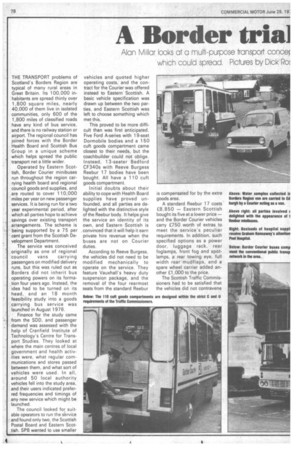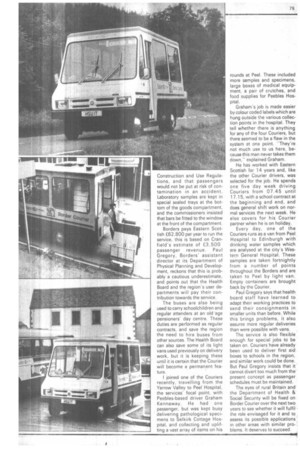A Border trial
Page 80

Page 81

If you've noticed an error in this article please click here to report it so we can fix it.
Alan Millar looks at a multi-puroose transport cancer which could spread. Pic-tires by Dick Ra
THE TRANSPORT problems of Scotland's Borders Region are typical of many rural areas in Great Britain. Its 100,000 inhabitants are spread thinly over 1,800 square miles, nearly 40,000 of them live in isolated communities, only 600 of the 1,800 miles of classified roads have any kind of bus service, and there is no railway station or airport. The regional council has joined forces with the Border Health Board and Scottish Bus Group in a unique scheme which helps spread the public transport net a little wider.
Operated by Eastern Scot. tish, Border Courier minibuses run throughout the region carrying health board and regional council goods and supplies, and are routed to cover 110,000 miles per year on new passenger services. It is being run for a two year experimental period, after which all parties hope to achieve savings over existing transport arrangements. The scheme is being supported by a 75 per cent grant from the Scottish Development Department.
The service was conceived originally as one of regional council vans carrying passengers on modified delivery runs, but this was ruled out as Borders did not inherit bus operating powers on its formation four years ago. Instead, the idea had to be turned on its head, and an 18 month feasibility study into a goods carrying bus service was launched in August 1976.
Finance for the study came from the SDD, and passenger demand was assessed with the help of Cranfield Institute of Technology's Centre for Transport Studies. They looked at where the main centres of local government and health activities were, what regular communications and stores passed between them, and what sort of vehicles were used. In all, around 50 local authority vehicles fell into the study area, and their users indicated preferred frequencies and timings of any new service which might be launched.
The council looked for suitable operators to run the service and found only two, the Scottish Postal Board and Eastern Scottish. SPB wanted to use smaller vehicles and quoted higher operating costs, and the contract for the Courier was offered instead to Eastern Scottish. A basic vehicle specification was drawn up between the two parties, and Eastern Scottish was left to choose something which met this.
This proved to be more difficult than was first anticipated. Five Ford A-series with 19-seat Dorrnobile bodies and a 150 cuft goods compartment came closest to their needs, but the coachbuilder could not oblige. Instead, 13-seater Bedford CF340s with Reeve Burgess Reebur 17 bodies have been bought. All have a 110 cuft goods compartment.
Initial doubts about their ability to cope with Health Board supplies have proved unfounded, and all parties are delighted with the distinctive style of the Reebur body. It helps give the service an identity of its own, and Eastern Scottish is convinced that it will help it earn private hire revenue when the buses are not on Courier duties.
According to Reeve Burgess, the vehicles did not need to be modified mechanically to operate on the service. They feature Vauxhall's heavy duty suspension package, and the removal of the four rearmost seats from the standard Reebur is compensated for by the extra goods area.
A standard Reebur 17 costs £8,850 — Eastern Scottish bought its five at a lower price — and the Border Courier vehicles carry £750 worth of extras to meet the service's peculiar requirements. In addition, such specified options as a power door, luggage rack, rear foglamps, front fog and spotlamps, a rear towing eye, full width rear mudflaps, and a spare wheel carrier added another £1,000 to the price.
The Scottish Traffic Commissioners had to be satisfied that the vehicles did not contravene Construction and Use Regulations, and that passengers would not be put at risk of contamination in an accident. Laboratory samples are kept in special sealed trays at the bottom of the goods compartment, and the commissioners insisted that bars be fitted to the window at the front of the compartment.
Borders pays Eastern Scottish £62,800 per year to run the service, this is based on Cranfield's estimate of £3,500 passenger revenue. Paul Gregory, Borders' assistant director at its Department of Physical Planning and Development, reckons that this is probably a cautious underestimate, and points out that the Health Board and the region's user departments will pay their contribution towards the service.
The buses are also being used to carry schoolchildren and regular attenders at an old•age pensioners' day centre. These duties are performed as regular contracts, and save the region the need to hire buses from other sources. The Health Board can also save some of its light vans used previously on delivery work, but it is keeping these until it is certain that the Courier will become a permanent feature.
I joined one of the Couriers recently, travelling from the Yarrow Valley to Peel Hospital, the services' focal point, with Peebles-based driver Graham Kennaway. He had one passenger, but was kept busy delivering pathological specimens to Selkirk Cottage Hospital, and collecting and uplifting a vast array of items on his rounds at Peel. These included more samples and specimens, large boxes of medical equipment, a pair of crutches, and food supplies for Peebles Hospital.
Graham's job is made easier by colour coded labels which are hung outside the various collec tion points in the hospital. They tell whether there is anything for any of the four Couriers, but there seemed to be a flaw in the system at one point. "They're not much use to us here, because this man never takes them down," explained Graham.
He has worked with Eastern Scottish for 14 years and, like the other Courier drivers, was selected for the job. He spends one five day week driving Couriers from 07.45 until 17.15, with a school contract at the beginning and end, and does general shift work on normal services the next week. He also covers for his Courier partner when he is on holiday.
Every day, one of the Couriers runs as a van from Peel Hospital to Edinburgh with drinking water samples which are analysed at the city's Wes tern General Hospital. These samples are taken fortnightly from a number of points throughout the Borders and are taken to Peel by light van. Empty containers are brought back by the Courier.
Paul Gregory says that health board staff have learned to adapt their working practices to send their consignments in smaller units than before. While this brings problems, it also assures more regular deliveries than were possible with vans.
The service is also flexible enough for special jobs to be taken on. Couriers have already been used to deliver first aid boxes to schools in the region, and similar work could be done. But Paul Gregory insists that it cannot divert too much from the present concept as passenger schedules must be maintained.
The eyes of rural Britain and the Department of Health & Social Security will be fixed on Border Courier over the next two years to see whether it will fulfil the role envisaged for it and to assess its possible applications in other areas with similar problems. It deserves to succeed.
go"
































































































































